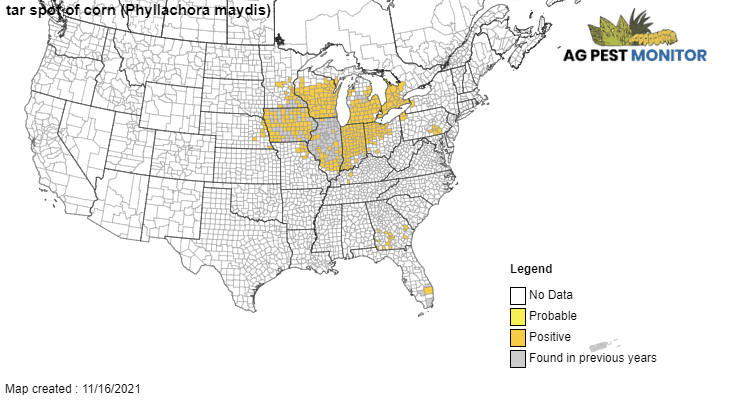By Louis Sutton
AgVenture Agronomy Lead

Tar spot distribution map as of November 16, 2021. Click to view the live interactive map via Crop Protection Network.
Tar spot has moved west quickly as it has infected fields across Missouri, Iowa, and has now been confirmed in some counties in Nebraska. If you’ve had tar spot in your field, you know the damage it can cause. If you’ve been lucky and not gotten it so far, you could still get it.
Tar spot is caused by the fungus Phyllachora maydis and is a relatively new foliar disease of corn. It was first identified in Illinois and Indiana in 2015. Tar spot appears as small, raised black spots scattered across the upper and lower leaf surfaces. These spots are ascomatum (fungal fruiting structures). If viewed under the microscope, hundreds of sausage-shaped asci (spore cases) filled with spores are visible. When severe, ascomatum can even appear on husks and leaf sheaths. Tan to brown lesions with dark borders surrounding ascomatum can also develop. These are known as “fisheye” lesions. It can cause severe yield loss on susceptible hybrids when conditions are favorable for disease. Affected ears can have reduced weight and loose kernels, and kernels at the ear tip may germinate prematurely.
Most people miss the first year they have tar spot as it affects the top of the corn canopy. At first, it may look like premature death. However, tar spot resides in the residue of the corn plant. It seems to handle a corn-soybean rotation, but can still affect the field the next time it is planted with corn. The disease spreads when the tar spot spores open and are blown in the wind.
Late in the season, other corn foliar diseases including rust can be confused with tar spot. An easy test can be done by scraping the spots with your fingernail. If the spots come off – it’s rust. If they don’t come off – it’s tar spot. Other grasses and plants can also host the tar spot spores, which is why a single year rotation may not be enough. Some fungicides may help, but more testing is needed for timing of the fungicide application to get the best effect.
Some hybrids are more affected by tar spot than others, so consult your AgVenture Yield Specialist to learn which products will be best for your operation.
